The Apple iPhone 6s and iPhone 6s Plus Review
by Ryan Smith & Joshua Ho on November 2, 2015 8:00 AM EST- Posted in
- Smartphones
- Apple
- Mobile
- SoCs
- iPhone 6s
- iPhone 6s Plus
Display
In pretty much any smartphone, displays are going to be one of the most important aspects of the user experience. If a display is dim or has a highly reflective display it will be unreadable outdoors. If the contrast is low, the display can become difficult to read and not particularly appealing to the eye. Other issues like lack of color stability and contrast stability with changes in viewing angles will be much more noticeable than on something like a laptop or desktop where the monitor is usually kept at a constant position in space relative to the eye. In order to evaluate these factors we use both relative comparisons and absolute measurements. Although the human eye is sufficient for relative comparison, for absolute measurements we use X-Rite’s i1Pro2 spectrophotometer for precise color and luminance measurements, along with X-Rite’s i1Display Pro colorimeter for accurate contrast figures. Hardware alone is insufficient for collecting and presenting data, so we also use SpectraCal’s CalMAN 5 with a custom workflow, which allows for collecting and presenting data in a readable manner.
In the case of the iPhone 6s and iPhone 6s Plus, the display appears to be effectively unchanged from the iPhone 6 and iPhone 6 Plus. The iPhone 6s retains the 1334x750 resolution of the previous variant, and the iPhone 6s Plus has the same 1080p resolution as well. Apple continues to use the same M2 scaler as well, which means that although the display’s physical resolution is 1080p Apple is actually rendering the display at 2208x1242 and scaling it to fit the display. The resolution of the iPhone 6s is on the low side relative to most Android devices, which is noticeable but the pixel density is sufficient to avoid any obvious problems here.
As with the iPhone 6, both the iPhone 6s and 6s Plus use dual domain pixels, which make the subpixels look more like chevrons under a microscope. This improves viewing angles by reducing the amount of color shifting that occurs when the display viewing angle is changed. As far as I can tell, Apple continues to be one of the few OEMs that pulls this off effectively. Although contrast and luminance aren’t perfectly consistent with changes in viewing angles, it basically looks like the display is painted underneath the glass. The iPhone 6s Plus does a better job at pulling off this illusion as the higher pixel density helps to eliminate some of the fuzziness or pixilation that might otherwise occur. Samsung gets close here, but for whatever reason ambient light causes noticeable interference effects and in general there’s noticeable color shift when moving the display around. Weirdly enough, the OEM that seems to be doing the best job here continues to be HTC with the One M9+.

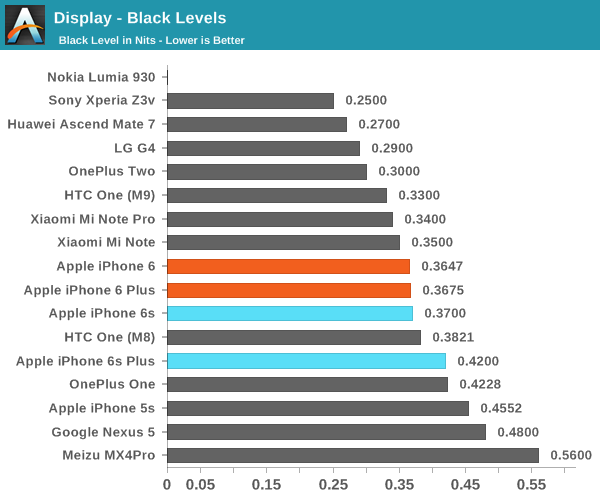
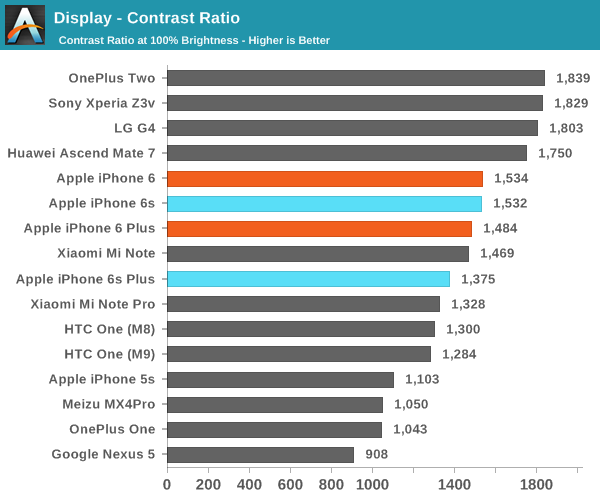
Moving on to our usual brightness and contrast testing, it looks like Apple has improved the maximum brightness of their displays with the use of the new LED backlight driver, but it’s important to note that in the case of the iPhone 6s, the maximum brightness isn’t constant. The behavior is relatively subtle, but with iOS 9 at maximum brightness the display brightness steadily lowers over the course of an hour by about 10 nits maximum. It looks like this effect tails off in both the rate of luminance decrease and overall luminance decrease as peak brightness approaches 500 nits, where the effect appears to be non-existent. It’s likely that this behavior is designed to reduce the battery impact of keeping the display at maximum brightness in all situations. Either way, peak luminance is high enough that it isn’t a struggle to read the display outdoors and contrast in low-light conditions also remains high due to the use of photo-alignment in the liquid crystal layer which helps to make the liquid crystals stay in the right shape.
iPhone 6s
iPhone 6s Plus

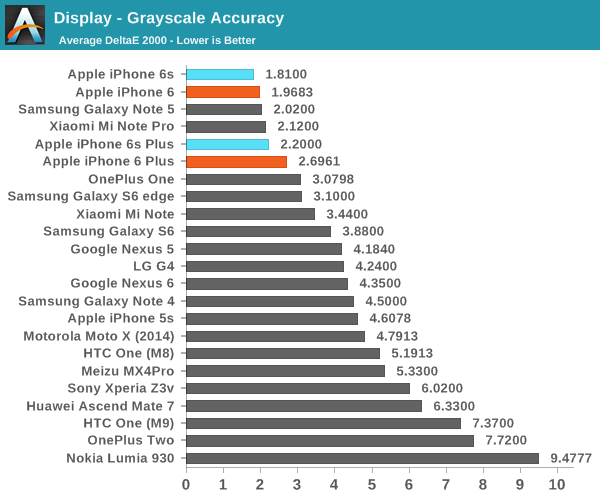
In grayscale, we don’t quite see the near-perfect white balance we saw last year but gamma remains almost impeccable when compared to the industry standard power 2.2 gamma. I suspect that the units we received this time are closer to the mean for white balance compared to last year, as in general due to the blue LED backlights used in most LCDs a colder color balance will generally require less power to display than a warmer one.
iPhone 6s
iPhone 6s Plus

In our saturation sweep testing, the iPhone 6s and 6s Plus both continue to track closely to expected values for sRGB, which is the current industry standard color gamut. I don’t really have any criticism here. The previous iPhone’s displays were of similar caliber, so this is pretty much par for the course if you’re used to iPhone displays.
iPhone 6s
iPhone 6s Plus
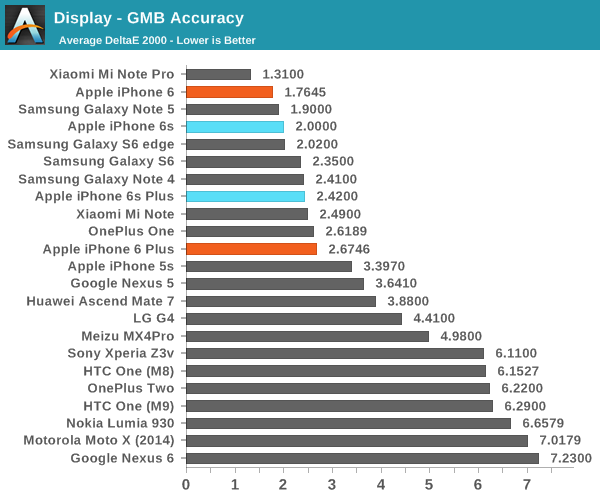
Similarly in the GMB ColorChecker, the iPhone 6s and 6s Plus both pass with flying colors. If you’re using an iPhone 6s or 6s Plus for any remotely color-critical work like viewing and/or editing photos and videos, it’s a pretty fair bet that you’ll be able to rely on these phones to provide an accurate color reproduction in pretty much any condition. Samsung does provide better contrast and the possibility of extra color saturation with their Galaxy S6 and Note 5, but this comes at the cost of potential for burn-in, increased power consumption in certain scenarios, and increased distortion with changes in viewing angles. I think this means that it basically comes out to a wash, but depending upon personal taste one may prove to be better than another.



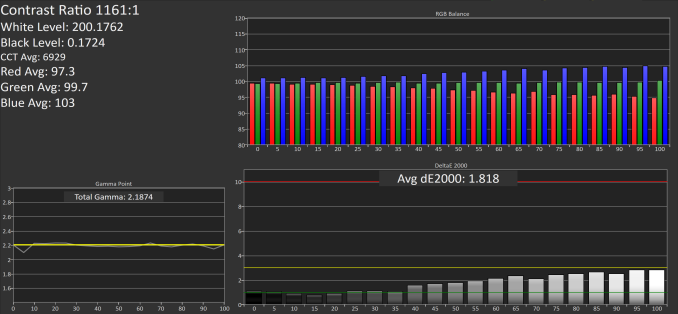
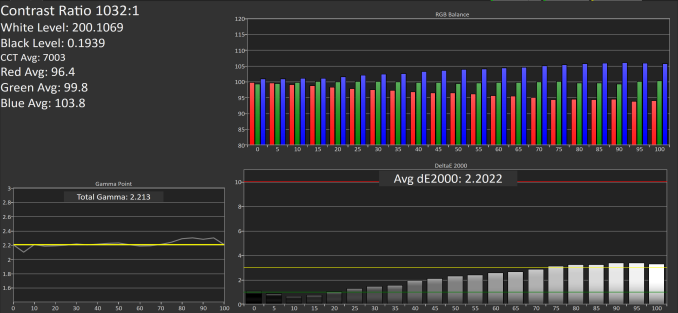
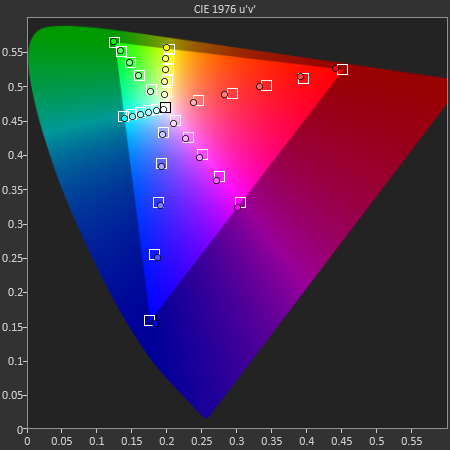
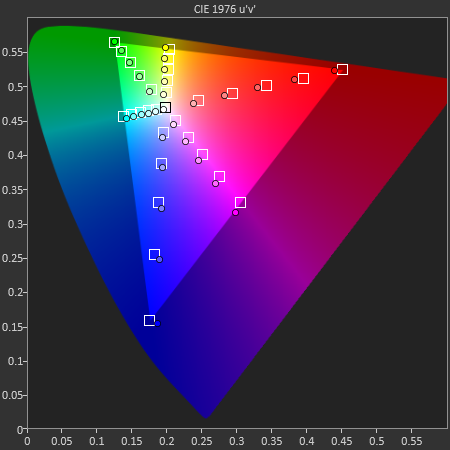
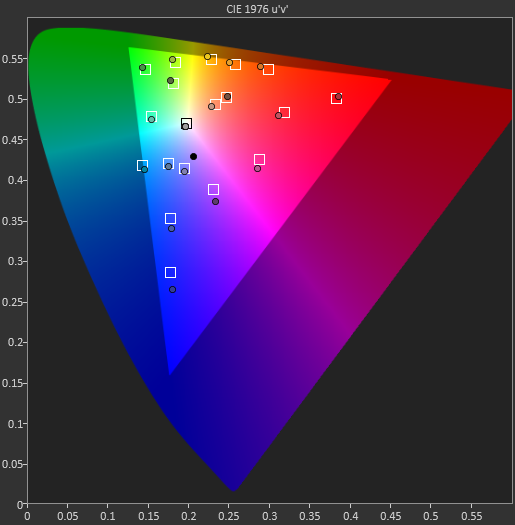
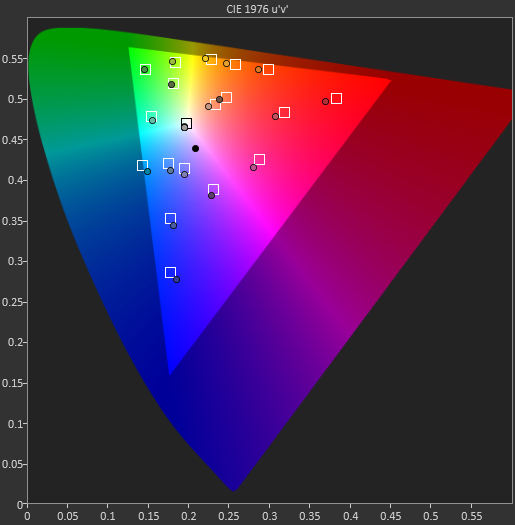








531 Comments
View All Comments
HotdogPercolator - Monday, November 2, 2015 - link
All of your "needs" are mine as well and I do them on a Jailbroken iPhone. I'm sorry if you're not smart enough to look past obstacles, but everything Androids do the iPhone can do just as well. Stop holding yourself back from a great experience. Branch out!BabelHuber - Monday, November 2, 2015 - link
How did you install rSAP-drivers on your iPhone? How did you unlock the bootloader? Can you install a different OS?Where do you put SD-cards in?
JLiRD808 - Monday, November 2, 2015 - link
Wow...we're sorry if you think your jailbroken iphone can do what a rooted android can do. While you have access to some apps that allow some customization, Android has that AND allows the OS to be completely tweaked and even swapped out! And Google encourages it!Can you even customize your CPU speed? Oh wait! You can speed up your animations so it LOOKS LIKE your CPU is operating faster lol. Nice one :P
Not that it matters, 90% of iphone 6s buyers are doing the same thing they were doing on their iphone 4/5.....Instagram, Facebook, the occasional game or two. Things'll be a few milliseconds snappier, sure. They'll only use "Live Photos" once or twice since it takes up extra storage. I give Apple credit for getting average users to drop big dollars on premium devices--they're truly amazing sheep-herders, and getting richer by the minute.
zeeBomb - Tuesday, November 3, 2015 - link
Uh but you can change how it performs tho...blackcrayon - Wednesday, November 4, 2015 - link
"Can you even customize your CPU speed?"LOL, so you can go from "slower than the best", to "even slower" to make up for the heat, battery life, and nosediving-performance-over-time compromises at the stock speed? Sounds really enviable!
tuxRoller - Friday, November 6, 2015 - link
That doesn't take processor variation into account.If you can stably undervolt your processor, you only gain battery life. Likewise, if you can overclock it and keep the voltages in check you see battery gains from race to idle
mikhapop - Monday, December 14, 2015 - link
yeah, a lot of us are tired of arguing apple fans, the iphone can't stand my needs (advanced or not).1- Install iTunes to connect my phone to pc
2- Very low RAM (stupid tabs refreshing)
3- Very low resolution screen
4- No stylus for taking notes (i have a note 4)
5- Can't tweak the system (playing with kernels to get better battery life or performance when needed)
6- Can't run advanced systems that i need them (a web development & linux specific systems)
the only thing i like about the latest iphones is the style (i like the way these phones look) but i think also the s6 edge is equally as good looking if not better.
JLiRD808 - Monday, November 2, 2015 - link
I think we're at "6 +" now supporting you lolblackcrayon - Monday, November 2, 2015 - link
Congratulations for encapsulating your total lack of knowledge of technology in such a clear, concise paragraph. Extra "expert" points for "the RAM is very little"...Macman2288 - Monday, November 2, 2015 - link
"SoC benchmarks are all synthetic and dubious" - so how would you test performance? This site is a benchmark site, that is what they do. If you hate benchmarks maybe this site is not for you."camera resolution s fully ignored, motion blur (the biggest problem for users) has never been tested" - you must not have read the article, motion blurr, image resolution, and video quality were all explored and displayed fairly for the reader to see.
"LTE is just cat 6" - 8-/ i have no words
"And lets not forget signal strength , god forbid you would ever mention how terrible iPhones are there" - are you talking about the iPhone 4? iPhones have the same chips and antenna designs as most other smart phones and appear to perform as well as more android phones.
"15 years ago you would laugh at people like you, irrational and lazy as you got." - You just described yourself today.
Yes my name says it all, I do enjoy apple products, but if was going to bash an article I would try to be a little more convincing. I have seen way better arguments for not buying an iPhone then what you displayed.